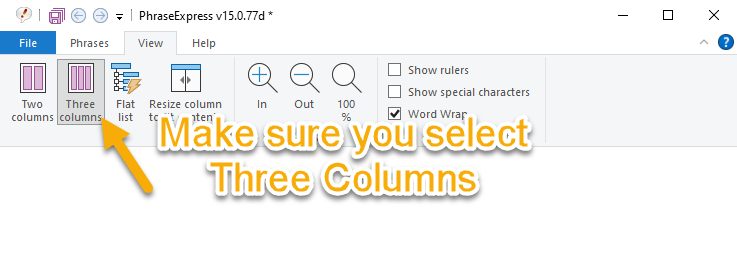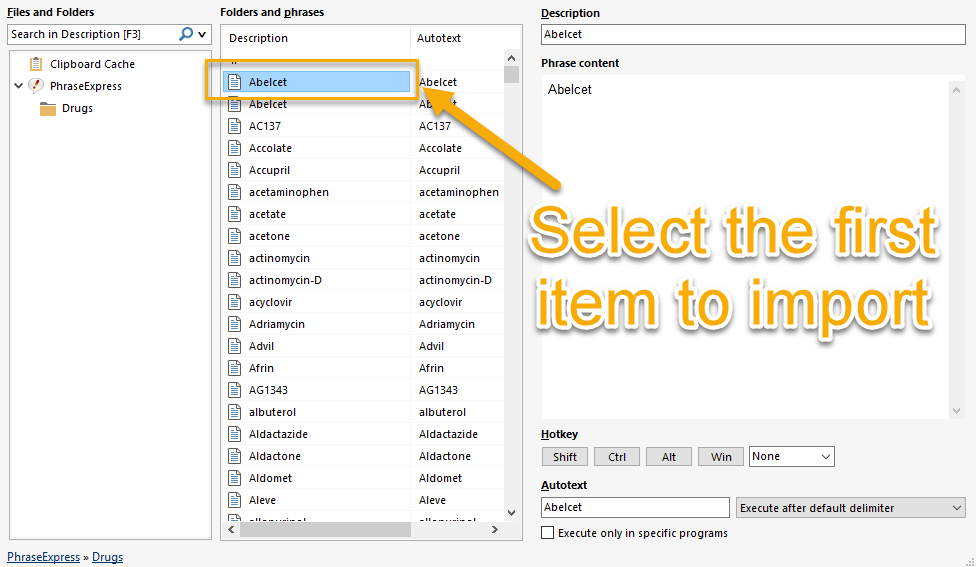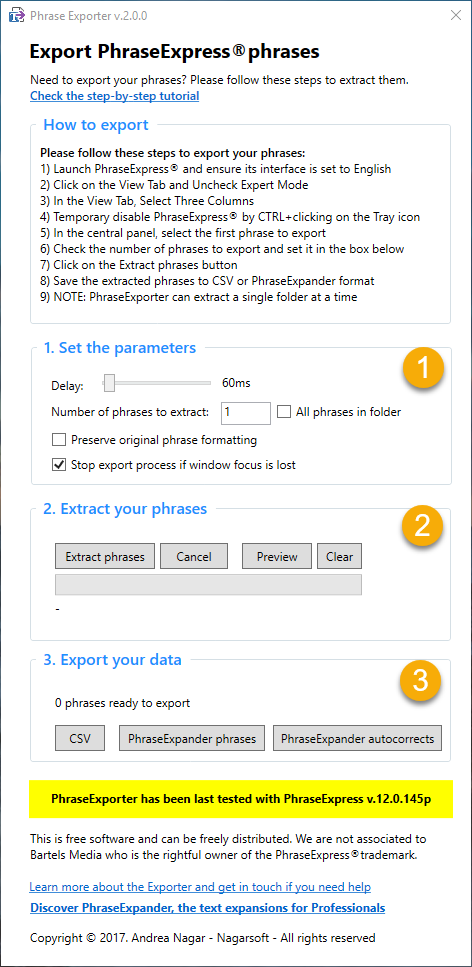Export your phrases from PhraseExpress
Convert them to text (in CSV format) and to PhraseExpander
In this short guide, I’ll show you to export your phrases from PhraseExpress® to a plain text file (CSV format), so you can edit them in Excel or use it in any way you like. And optionally, I’ll show you how you can import them back into our text expander tool, PhraseExpander.
How to setup PhraseExpress® to export your data
1. Backup your data
It’s a good practice to create a backup copy of the folder containing the phrases you want to export.
- Right click on the folder that you want to export
- Click on Export → Export as PhraseExpress phrase file
This will ensure that you’ll be able to get to your data in the unlikely case that something goes wrong.
2. Set PhraseExpress to Easy mode and Three columns

3. How many phrases do you want to export?
You need to know how many phrases you want to export. If you want to export all the phrases in a folder, right click on the folder and choose Properties to check how many phrases it contains. You’ll need this value later when setting up the PhraseExpress Exporter.3

You can also set Phrase Exporter to export all the phrases until it reaches the end of the folder (up to 5,000 phrases) by choosing the All phrases in folder checkbox.
4. Select the first phrase to export
Select the first phrase that you want to export.

You are done with PhraseExpress and we are ready to run the Exporter.
Use Phrase Exporter to extract the data
1. Download and run Phrase Exporter
The Phrase Exporter tool is free to download. Once downloaded, double-click on its icon to open it.
Get started by clicking on the link below.
2. Extracting the phrases
Using PhraseExporter will automate the tedious process of copying and pasting the contents of each phrase.

To extract the phrases, follow these steps:
- Choose the number of phrases you want to export (if you want to export items in a subfolder, you’ll need to repeat the procedure). It’s recommended to start extracting a few phrases at a time first, to make sure that everything is working as expected.
- Click on Extract phrases: the procedure will start and you’ll see the selection change in Phraseexpress. Make sure that you don’t do any operation on your computer during the export (using the mouse or keyboard will halt the operation).
- You can repeat (2) to extract more data. Once the operation is complete, you can choose how to export your data (as CSV file, for easy import into Excel or as PhraseExpander glossaries to move your data to our text expansion application).
Optional settings:
Delay: you do not normally need to change this value. If you notice that your phrases are not exported properly, you can try increasing it.
All phrases in folder: Phrase Exporter will try exporting all the phrases contained in the folder (up to 5,000 phrases). If you need to export more, you can repeat the operation.
Preserve original phrase formatting: the exporter can extract also the formatting information from your phrases. Those will be available only if you decide to export your phrases as PhraseExpander phrases. Please select this option ONLY if the phrases you want to export contains special formatting.
Preview: you can click on this button to check the data that have been exported. The preview is shown as CSV.
NOTE: test the export with a small number of phrases first to make sure everything is working as expected. If you are having issues with the extraction, try increasing the delay. Make sure that you are using the latest release of PhraseExpress and don’t have too many applications running at the same time on your system. Try closing a few of them and repeat the procedure. If you are still having issues, please let us know and contact support.
Limitations
Export a single folder at a time: you can export a single folder at a time. If you have many folders, you will need to repeat the operation for each folder.
Macros are not translated: the macros are not translated. If you want to implement macros in PhraseExpander, you’ll need to modify them manually.
Rich text phrases are exported in plain text: formatting of rich text phrases is lost in the export.
Export your data
Once you have extracted your data, you can export it into Excel (as a CSV file) or into our text expansion tool, PhraseExpander (if you haven’t installed it yet, you can download a free trial of PhraseExpander here).
1. Export as CSV file (to import in Excel or any other application)
Click the CSV button and choose the destination file. You can then open the file in Excel or any text editor.
2. You can export data to PhraseExpander in two ways:
Phrases: uses to expand an abbreviation into a longer phrase or sentence. By choosing this option you can preserve original formatting.
Click on the PhraseExpander phrases button.Autocorrects: meant to automatically correct a wrongly typed text
Click on the PhraseExpander autocorrect button
Import your data into PhaseExpander
Once you have your PhraseExpander glossary file, you can import it into PhraseExpander by following this procedure:
- Open PhraseExpander
- Click on the Import Tab
- Click on Glossary
- Choose PhraseExpander v.4 glossary
- Choose the glossary file you have created
- Follow the instructions on screen to import your data
Want to switch to a more user friendly tool?
Try PhraseExpander Free for 21 Days
Getting started takes only 5 minutes…